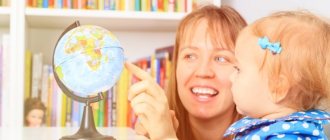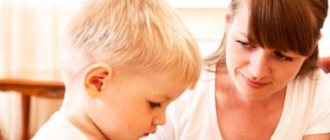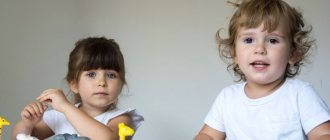Alalia is a systemic underdevelopment of speech function or its complete absence. The main causes of the disease are considered to be organic lesions of the speech areas of the brain that occurred in the first 2-3 years of life or in utero. The clinical diagnosis of alalia is made by a neurologist and a psychiatrist. In speech therapy, speech pathology caused by congenital or acquired brain defects is called general speech underdevelopment (GSD).
Alalia disease is characterized by:
- agrammatisms;
- distortion of sounds;
- late appearance of speech;
- violation of syllable structure;
- small vocabulary;
- violation of phonemic processes.
A patient with alalia needs to undergo a thorough neurological, psychological and speech therapy examination. The disease occurs in 1.5% of preschool children and 0.5% of schoolchildren.
Comprehensive treatment of underdevelopment of speech function includes:
- taking medications;
- physiotherapeutic procedures;
- working with a psychologist, neurologist and speech therapist.
Causes of alalia
Alalia disease is provoked by various anomalies of pre-speech ontogenesis.
In the antenatal (intrauterine) period, speech pathologies can be caused by:
- hypoxia;
- prematurity;
- torch syndrome;
- perinatal pathology;
- asphyxia of newborns;
- somatic disease of a pregnant woman.
Doctors note a genetic predisposition to the development of alalia. The history of patients with general speech underdevelopment reveals a chain of hereditary factors that provoke dysfunction of the speech areas of the brain.
Etiopathogenetic factors have a significant influence on the physiological development of the speech apparatus:
- rickets;
- meningitis;
- malnutrition;
- encephalitis;
- endocrinopathies;
- traumatic brain injuries;
- lack of competent child development.
In case of intrauterine, congenital or other organic damage to the brain in the first years of a child’s life, the development of nerve cells (neuroblasts) is inhibited. This pathology leads to neuronal inertia and functional depletion of brain cells. In case of alalia, multiple bilateral nature of deviations in the development of speech function, including compensatory capabilities of the brain, are diagnosed.
Motor alalia
Motor alalia is characterized by the presence of a lesion in the brain. With this form of the disease, there are problems with speech, but intelligence is preserved. The part of the cerebral cortex that is responsible for speech production is affected. This form of pathology usually develops before the age of 3 years; as the child grows older, he begins to have complexes about his condition and uses facial expressions and gestures in conversation.
The main difference between motor alalia is that the child has difficulty speaking without visual perception. If he does not see a specific image, he cannot name it. Only during perception are neural connections formed between the centers of the cerebral cortex. Simple phrasal sentences remain in a rudimentary state, for example:
- "I'm here";
- "Come here";
- “Let me play”;
- “Let's go home”, etc.
Parents are not always able to detect motor alalia in the early stages, which is why they do not immediately turn to specialists. For full treatment, constant monitoring by a neurologist is required. The speech therapist selects a program depending on the specific clinical situation. The mild form is easier to correct; if you contact specialists in a timely manner, the prognosis is favorable.
Alalia classification
Each area of clinical medicine has its own narrow classification of alalia, which is based on the causes of occurrence, existing pathologies of psychomotor development and the degree of speech underdevelopment.
Modern speech therapy suggests taking as a basis the classification of alalia by V.A. Kovshikov:
- Motor (expressive).
- Sensory (impressive).
- Mixed (sensorimotor).
Expressive alalia
In most cases, motor (experimental) alalia is caused by intrauterine organic damage to the cortical speech-motor analyzer. At the same time, the newborn does not have his own speech, but he perfectly perceives the speech of others. It is necessary to distinguish between efferent and afferent expressive alalia.
Efferent motor alalia is diagnosed with abnormalities of the premotor cortex (posterior part of the inferior frontal gyrus, Broca's area). The pathology manifests itself in kinesthetic articulatory apraxia (distortion of the sound of consonants and vowels). During physiological development, the premotor cortex in a child is responsible for the coordination and sequence of movements, which is very important for the formation of speech. Children with efferent alalia find it difficult to repeat a series of movements; they have difficulty reproducing correct articulation. It is with this problem that the phenomenon of persistence is associated: the inability to reproduce syllables in the required order.
Afferent motor alalia develops as a result of lesions in the postcentral zone (parietal parts of the left hemisphere). In healthy children, the postcentral zone is responsible for analyzing sensations at the time of conversation, and the synthesis of a motor program immediately occurs: open the mouth, lower the jaw, inhale air, raise the tongue. With afferent alalia, the child is not able to independently perform a chain of movements to pronounce sounds, so smearing, rearranging or swallowing of sounds occurs. Simply put, the baby has no idea about the sequence of actions of the articulatory apparatus when speaking, and it is difficult for him to reproduce movements even when repeating after his parents. In case of motor alalia with concomitant developmental pathologies, the child is assigned a disability.
Impressive alalia
The main cause of sensory alalia is damage to the auditory-speech analyzer in the cortical region (posterior third of the superior temporal gyrus, Wernicke's center). Patients with this disease have good hearing and developmental abilities. The main problem of correcting pathology is poor memory for pronunciation and a gap in understanding between the sound and meaning of words. The consequence of such dissonance is a lack of contact with others, a distortion of visual perception and a delay in the overall development of the child’s psyche.
Clinical picture and behavioral characteristics of children
With motor alalia, a child may have a large passive vocabulary, but finds it difficult to name even well-known words. Children cannot repeat even simple words after an adult, despite having a developed articulatory apparatus. In words they rearrange and replace syllables, omit sounds. These substitutions are not permanent; in some circumstances, children replace syllables, in others, they replace sounds in the same word.
It is especially difficult for them to pronounce words expressing abstract concepts and generalization words. Children with alalia are aware of their shortcomings. A child with high intelligence is more critical of his speech; when communicating with others, he replaces words with facial expressions and gestures. When parents have excessive demands on pronunciation, when the speech therapist tries to “introduce” sounds, despite the fact that those around him do not understand him, he shows negativism.
The scarcity of phrasal speech is very noticeable - children speak in simple sentences or sentences consisting of only subjects. If you don’t work with your baby, he won’t be able to master the grammatical structure of speech. Children make mistakes in agreeing nouns with prepositions and use case endings incorrectly.
With age, more and more automation of speech is required, and afferent motor alalia in children only increases the child’s problems. Children suffering from this pathology are diagnosed with disorders of attention, memory, thinking, analysis and synthesis of words and phenomena, emotions, will, and behavior.
The symptoms of alalia exclude balanced behavior - it is not often found in children with this speech disorder; usually they are either inhibited or too excited. Most children have impaired fine and gross motor skills, are clumsy, and their movements are disinhibited or slow.
A child with alalia has little desire to understand the surrounding reality; he is inattentive and often distracted. Visual and auditory memory in such children is reduced; such children do not strive for intellectual activity. In the process of completing tasks, they do not strictly follow instructions and therefore often make mistakes.
Alalia symptoms
Symptoms of motor alalia
With expressive alalia, the child is diagnosed with psychological and neurological abnormalities. Symptoms of nervous disorders can manifest themselves in a disorder of motor skills: poor motor skills, clumsiness, lack of coordination of movements. Such children find it difficult to cope with lacing shoes, fastening buttons, self-care, and putting together puzzles.
Characteristic features of the psychological development of patients with motor alalia:
- speech negativism;
- lack of attention;
- small vocabulary;
- low performance;
- poor assimilation of material;
- violation of sound pronunciation;
- deviations of the emotional-volitional sphere;
- hyperactivity or, conversely, inactivity.
It should be noted that there is a strong dissociation between expressive and impressive speech when diagnosed with “motor alalia”. The first speech skills (babbling, googling, sounds, phrases) appear with a delay and a characteristic reduction. The lack of dynamic development of a speech stereotype can be a consequence of stuttering.
Such children have a predominance of nouns in the nominative case in their vocabulary and difficulties in the formation of grammatical word forms. Speech in the motor form of the disease consists of simple short sentences, sometimes incoherent. The child is not able to consistently talk about things, convey events and explain the essence of phenomena. Intellectual development with motor alalia can be completely restored after correction of speech disorders.
Symptoms of sensory alalia
Characteristic symptoms of sensory alalia are:
- disturbances of perception;
- lack of ability to understand the meaning of someone else's speech.
Patients with sensory alalia experience hyperacusis: increased sensitivity to squeaks, rustles, the crunch of snow, the sound of rain, and the rustling of paper. Children are acutely aware of such side sounds and may experience discomfort in their ears and head.
Impaired phonemic hearing in the sensory form of the disease prevents patients from correlating heard words with objects or phenomena. During speech therapy sessions, children with sensory alalia develop logorrhea - incoherent reproduction of all familiar phrases and sounds, while speech is accompanied by gestures and lively facial expressions.
In the severe form of sensory alalia, the patient is diagnosed with a complete lack of speech and understanding of others. Experts practice teaching “lip reading,” which makes it much easier for a child to comprehend speech. Children with sensory alalia are often misdiagnosed as autism, hearing loss, mental retardation, dysarthria.
Separately, sensory underdevelopment of speech function is quite rare. In most cases, sensorimotor alalia is diagnosed. This double pathology indicates the inseparability of the speech-motor and speech-auditory analyzers.
If you experience similar symptoms, consult your doctor
. It is easier to prevent a disease than to deal with the consequences.
Silent child. Alalia
Home — About speech therapy — Silent child. Alalia
Every family eagerly awaits their child's first words. But time passes, and there are almost no words. Or they are there, but they are so illegible and there are so few of them that the family begins to worry. Parents go to specialists and hear: “Your child has alalia.” The term sounds scary and incomprehensible. Let's figure out together what it is.
Each child is unique, so the baby does not always fit into standard developmental norms (when he walked, he began to eat himself with a spoon, he started talking). But, nevertheless, there are a number of alarming factors that should be paid attention to
- this is the so-called “red flag”:
1 year: no babbling, the child does not point to objects and does not communicate with gestures.
1 year and 3 months - does not look at toys, does not show objects and people by name to parents (normally 5-10).
1 year and 5 months - still no first words.
1 year and 6 months - the child does not say “daddy, mommy”, cannot follow simple instructions (smile, raise your hand, etc.).
2 years - does not show body parts, speech contains less than 20 words.
2 years and 5 months - does not answer questions, does not use two-word sentences (Example: mom is walking, let's go for a walk).
3 years old - does not understand prepositions and many verbs, cannot follow two-step instructions (Example: take the typewriter, and now give it to dad), speech has less than 200 words.
If a child has similar disorders, then you should contact a specialist as soon as possible, because Perhaps he has a speech delay of the alalia type.
Alalia
– a speech disorder, which manifests itself in the absence or underdevelopment of speech due to damage to the speech areas of the brain during fetal development or at an early age. In this case, all components of speech are disrupted: sound pronunciation and syllabic structure, phonemic perception, vocabulary and grammar of the native language, coherent speech. This diagnosis can only be made by a doctor (psychiatrist or neurologist) when the child reaches three years of age. Until this time, we are talking about delayed speech development.
Causes
, which can cause alalia are varied. They can act from the moment when the baby is still developing in the mother’s stomach, and until his third birthday.
Alalia is varied in its manifestations: from simple verbal awkwardness to a complete inability to speak and understand spoken speech. There are different approaches; traditionally, they distinguish between sensory (impressive) and motor (expressive) alalia.
Sensory alalia is a disorder of speech understanding that is caused by damage to the temporal lobe of the brain (Wernicke's center). With this type of alalia, the child hears (physical hearing is preserved), but does not understand spoken speech. There are few children with this diagnosis. Identifying and distinguishing sensory alalia from other disorders (for example, early childhood autism, mental retardation, etc.) is difficult.
To better understand how a child with sensory alalia hears speech, imagine that you are in another country, for example, in China. Everyone around you is talking, asking questions, but you don’t understand anything. There is a gap between the meaning/meaning of the word and its “sound shell”, i.e. native speech sounds like a foreign one. All sounds are perceived as a “heap”, speech merges with the surrounding noise.
Children with sensory alalia are characterized by unstable reactions to sounds, i.e. The baby can recognize the speech of his loved ones and not react to the speech of strangers. And if various interferences appear during speech (extraneous noise, the appearance of new people), then these difficulties are aggravated even more. In addition, many children have difficulty distinguishing everyday sounds (Example: what sounds, a hair dryer or a refrigerator?), determining the source and direction of the sound.
Therefore, diagnosis is very important, to separate children with sensory alalia from other children with similar manifestations (autism, hearing loss, etc.) in order to correctly select the types of help and successfully overcome this complex disorder.
Motor alalia
– this is a systemic underdevelopment of speech, in which the child experiences difficulties in constructing an independent speech utterance, while the understanding of addressed speech is relatively intact. This type of alalia is also caused by damage to the parts of the cerebral cortex that are responsible for the motor production of speech. This type of alalia is divided into two forms: afferent and efferent.
Afferent motor alalia is caused by damage to the parietal cortex of the left hemisphere of the brain. This department is responsible for assessing sensations during the speech process: with the help of what movements this or that sound is produced, where we direct the breath at this time, etc. Awareness of this helps to build speech motor complexes, that is, a series of movements to pronounce a certain sound. A child with this form of motor alalia experiences difficulties in constructing these motor programs, since he does not feel the position of the organs of articulation (lips, tongue) and therefore often replaces sounds or does not pronounce them at all. For example, instead of the sound “y” one hears a vague “iy”, instead of “tyu” - “syu”, “gu” - “bu”, etc. That is, sounds are replaced even by ones that are distant in sound and articulation. The syllabic structure is certainly broken: for example, instead of “give” - “da”, “porridge” - “ka”, instead of “car” - “bi”, “ride” is also “bi”, that is, they call different words in one word .. It is difficult for such children to reproduce and remember articulatory patterns even with the help of an adult.
Motor efferent alalia is a consequence of damage to the frontal parts of the cerebral cortex (Broca's center), which combine sounds, words, sentences from individual articulatory movements and “verify” this sequence. Children with this form of motor alalia experience difficulties in transitioning from one sound to another and in reproducing the correct syllable sequence. For example, “sem” instead of “seven”, “khonona” is “good”, “shomasa” is “study”, the speech of such a child is incomprehensible to a stranger. and so on. Difficulties in the transition from one syllable to another are manifested in pauses: “Pa pu is called I go r” and in repetitions of syllables: “found fingers” - found a finger. There are agrammatisms in speech; when asked how old you are, the answer is “five” - five. This form of alalia occurs 9-10 times more often than the afferent one.
To imagine what the speech of a child with motor alalia sounds like, we will give an excerpt from the recording of the boy Vanya (4 years and 11 months), he was telling a turnip fairy tale: “Vyaasa...vyasa. Ani her... tinui-tinui, and couldn’t, and couldn’t make it. Basai ani...ai...zais...mysku...toss." A rough translation sounds like this: “They pulled and pulled, but couldn’t, and didn’t make it. They abandoned her. The hare and the mouse too.” As you can see, for a child who is almost 5 years old, this fairy tale is not so easy to understand or retell.
To summarize, afferent motor alalia manifests itself in difficulties in constructing speech movements, and efferent in difficulties in constructing a sequence of sounds, in combining sounds into words.
In addition to speech manifestations, most children with motor alalia are characterized by motor disorders and an insufficient level of development of fine and gross motor skills. Such children have difficulty fastening buttons and tying shoes; assembling puzzles, appliqués, and modeling also cause difficulties.
Children with alalia get tired quickly, their attention is exhausted, and their perception is fragmented.
Alalia
- this is a speech disorder, the correction of which is carried out not only by a speech therapist, but also by a doctor and a psychologist. A psychiatrist and neurologist will select appropriate drug treatment. The psychologist will deal with the correction and development of mental functions such as perception, attention, thinking. Only an integrated approach will help you “cope” with alalia. This work is lengthy, but it is often possible to achieve verbal communication of the child.
The content of the work is determined individually and depends on the child’s speech capabilities. Sometimes children with alalia do not have basic eye contact, i.e. they simply do not look at the speaker and do not engage in communication. Then the goals and objectives of the work will begin not with the challenge of speech, but with deeper goals - with establishing eye contact, with attracting the child’s attention to the teacher’s speech, with the ability to imitate simple movements upon request, etc. Just as each child is unique, so are the methods of working with alalik. Their speech therapist selects them individually for each child.
Alalia is a complex speech diagnosis. Its correction takes a long time (from several months, in rare cases, to several years) and requires comprehensive assistance: doctors, psychologists, speech therapists. The best age to start working is 3-4 years, when children develop a thirst for knowledge and self-criticism. Based on this, we can talk about the need for early diagnosis, because the earlier alalia is detected, the more time remains for corrective work and the less chance of developing secondary intellectual defects.
Share:
Find out more about the Center's services and sign up for a consultation or lesson
You can call (812)
640-90-77
, or by filling out the form below.
Diagnosis of alalia
Patients diagnosed with alalia need to be examined by the following specialists:
- Speech therapist - for perinatal history, identifying features of speech and psychomotor underdevelopment, as well as drawing up a model of lexical and grammatical structure, correction of phonemic processes and impressive speech.
- Neurologist - to identify the source of neuralgic dysfunctions and genetic abnormalities.
- Psychologist - to diagnose auditory-verbal memory, timing of psychomotor development, articulatory motor skills.
- Otolaryngologist - when drawing up a therapeutic treatment plan, it is necessary to exclude damage to the function of the hearing aid.
For additional diagnostics and identification of the degree of brain pathologies, the following is carried out:
- EEG;
- otoscopy;
- audiometry;
- MRI of the brain;
- X-ray of the skull;
- echo-encephalography.
Silence mode when correcting sensory alalia
The speech therapist recommends to parents how to properly organize the baby’s speech and sound modes. Temporarily, adults are asked to talk to the child as little as possible, organizing a quiet hour or a hearing rest day. During this time, it is necessary to eliminate unnecessary sounds in the children's room: a playing TV, a computer, a tablet; sometimes it is recommended to remove sounding visual stimuli (toys, books). This sound mode helps to increase children's sensitivity to sounds.
The next stage is the awakening of interest in the sounds surrounding the child, the emergence of interest in imitation and perception of one’s own speech.
In the first lessons, the speech therapist develops attention, helping the child to focus on sound stimuli, teaching him to distinguish between two or three sounding objects, for example, a pipe, a tambourine and spoons. Then he is given the opportunity to play various games that will help him develop correct, smooth, diaphragmatic breathing.
At the next stage of correction, the speech therapist’s main task is to draw the child’s attention to laughter, crying and other reactions of people around him, to develop perseverance and the ability to copy the emotional reactions of others. If he is tired, the lesson stops. For the work of a speech therapist to be successful, correction is carried out from 2.5-3 years. The specialist must systematically influence each component of speech.
Treatment of patients with alalia
The system of corrective action for sensory, motor and mixed alalia should include a set of procedures with an impact on the pathology itself and accompanying diagnoses. In correctional centers, specialized preschool educational institutions and speech therapy hospitals, medical, psychological and pedagogical therapy is used when treating patients with alalia. Drug treatment is mainly aimed at stimulating the formation of brain structures.
For pathologies of speech centers in the cerebral cortex, experts note the high effectiveness of the following physiotherapeutic procedures:
- DMV;
- IRT;
- hydrotherapy;
- laser therapy;
- electrophoresis;
- magnetic therapy;
- electropuncture;
- transcranial electrical stimulation.
When treating alalia, it is important to focus on the development of motor skills, thinking, and memory. The disease is caused by systemic disorders, therefore speech therapy treatment should be based on full coverage of sound-letter formulations and combinations, visualization of concepts, as well as concentration. Speech therapy massage and logorhythmics must be carried out along with speech therapy classes.
It is recommended that children with alalia begin to learn the alphabet, counting and writing as early as possible. Such skills allow you to better develop memory, learn to compose syllables into words and control speech.
In complex therapy of motor alalia, the main work should be aimed at:
- stimulation of speech activity;
- development of coherent speech;
- formation of speech reserve;
- grammatical format of the statement.
With a diagnosis of “sensory alalia,” the emphasis of speech therapy should be focused on developing skills to distinguish speech and non-speech sounds, differentiate words, and understand speech instructions.
It is important to systematically work through:
- correct phonemic awareness;
- acoustic skills;
- associative series.
Diagnostic and treatment methods
Children with any form of alalia need the help of a speech therapist, neurologist and psychologist. Neurological diagnostics helps to identify the extent of brain damage using an electroencephalogram and MRI. To exclude hearing loss, otoscopy and audiometry are performed, and in order to differentiate the symptoms of alalia from similar symptomatic pathologies, such as delayed speech development, dysarthria, autism, speech therapists and psychologists are involved in the work of the neurologist.
Sensorimotor alalia requires speech therapy examination. The speech therapist determines the following parameters:
- level of speech understanding;
- determining the number of words in the dictionary, including all speech manifestations;
- identifying opportunities for speech imitation;
- identifying the possibility of using prepositions;
- identifying the state of the organs of articulation and sound pronunciation;
- determining the maximum volume of sentences used;
- research into the possibility of changing words by numbers.
Alalik children with minimal damage to speech development are assessed for the ability to retell a simple fairy tale and answer questions about its content, and the ability to compose a story based on a series of pictures. Diagnosis is carried out in the presence of parents, using a large amount of stimulus material (toys, pictures). The speech therapist strives to establish close contact with the child.
Correction of the defect is carried out in a complex manner. Treatment of alalia in children requires the use of medications that stimulate the maturation of brain structures:
- vitamins B5 and B12;
- Cogitum;
- Gammalon.
{gallery-0}
To eliminate sensory and motor alalia, physiotherapy and microcurrent reflexology are prescribed. Drug treatment of motor alalia will be more effective if it is accompanied by corrective classes with a speech therapist, speech pathologist, or psychologist. Specialists work on the development of speech and other higher mental functions: attention, memory, thinking.
Forecast and prevention of ANR
For motor alalia, the prognosis for recovery is always favorable. The result of therapy for sensory and sensorimotor diseases is uncertain and depends on many factors: the degree of damage to the speech center of the brain, side pathologies, and the presence of psychosomatic disorders. At school age, children with ODD are faced with written language disorders: dyslexia and dysgraphia.
Prevention of alalia includes:
- monitoring the course of pregnancy;
- long-term breastfeeding;
- early diagnosis of congenital pathologies;
- complex physical development of the child.
This article is posted for educational purposes only and does not constitute scientific material or professional medical advice.
Sensory alalia
With sensory alalia, the perception of other people's speech is impaired due to damage to the speech-hearing analyzer. Sensory alalia is very rare, perhaps due to imperfect diagnostics.
Features of the pathology:
- Many children with this pathology do not even respond to their own name and do not understand speech addressed to them.
- Children may understand individual words but lose the meaning of statements with the same words.
- In other cases, they understand the instructions for completing the task, but outside of this situation they cannot understand the task.
- Sometimes he incoherently repeats words he knows - logorrhea develops.
Information reaches children's brains in fragments, because they perceive it very poorly by ear. This results in incomprehensible, distorted speech, although the speech activity of such children is quite high.
Realizing their defect, many children become shy, although they do not lose the desire to communicate. Other alaliks are excitable and irritable, and may exhibit negativism and affective outbursts.
In some cases, a complex disorder is diagnosed - sensorimotor alalia.
How to help your baby?
Specific treatment methods and prognosis for motor alalia depend on the results of the examination. The program is always compiled individually. A mandatory part of it is classes with a speech therapist, but sessions with a psychologist, treatment of the nervous system, and neurorehabilitation may be necessary. In our center, alalia treatment is carried out comprehensively, children receive all the help that is necessary in their particular case. Our center’s specialists work with both simple cases and those in which motor alalia is combined with other developmental disorders, focusing on the best possible result for each patient.









